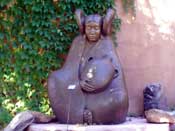The adobe and log buildings along with the quaint downtown Plaza make Santa Fe look like a relic of the Old West. Numerous cathedrals, sculptures, southwestern shops and trading posts give you the feeling of a town growing out of the desert in the 1800's - but with the charm and elegance of a modern city.
Santa Fe History
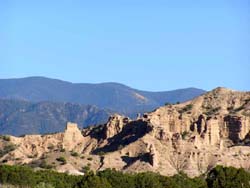
Paleontologists feel that Paleo-Indians lived in the Santa Fe area as long as 10,000-12,000 years ago based on stone tools and other artifacts. From 1,000 B.C. to approximately 1250 A.D. a thriving Pueblo Indian culture in the region (evidenced by the cliff dwellings at nearby Bandelier National Monument) existed. This culture was based on the cultivation of corn, beans and squash, along with hunting of buffalo and small animals. The ancient Pueblo people nearly disappeared from the region around 1250 A.D. due likely to drought or overpopulation, with Navajo and Apache Indians moving into the area. The first Spanish settlers under Juan de Onate arrived in 1598, who left in 1610, and was followed by Don Pedro de Peralta, who founded the capital name Santa Fe (meaning "Holy Faith" in Spanish).
In 1680, the local Indians under a man named Pepe rejected Spanish rule and the Spaniard's retreated toward what is now El Paso, Texas. Don Diego de Vargas led the reconquest of New Mexico in 1692, praying to a statue of the Virgin Mary, promising a festival in her honor which is held to this day.
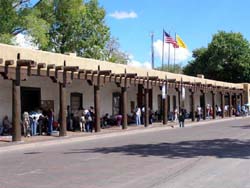 By the 1800's, the Spanish empire was crumbling; war with the United States in 1846-1848 resulted in much of the present day Southwestern U.S. being ceded to the U.S. in the most significant nation building move since the Louisiana Purchase. Railroads transformed Santa Fe in the 1880's and the town became a major Western trading post. New Mexico finally became a state in 1912 after several failed attempts, with President Taft signing the statehood bill.
By the 1800's, the Spanish empire was crumbling; war with the United States in 1846-1848 resulted in much of the present day Southwestern U.S. being ceded to the U.S. in the most significant nation building move since the Louisiana Purchase. Railroads transformed Santa Fe in the 1880's and the town became a major Western trading post. New Mexico finally became a state in 1912 after several failed attempts, with President Taft signing the statehood bill.
In the 1940's, the region attracted scientific attention due to the development of the atomic bomb at nearby Los Alamos, initiating a new age for wartime and for mankind. In recent years, Santa Fe has received the attention of numerous celebrities who make their home in and around the scenic mountains and local foothills. More Santa Fe history...
Santa Fe Restaurants
If you like Mexican food, Santa Fe is the place to be - but the cuisine is more "Southwestern" as opposed to "Tex-Mex" enjoyed in other areas. Several fine and casual dining establishments dot the landscape, including
Anasazi,
Coyote Cafe,
Fuego,
Geronimo, La Boca, La Casa Sera,
PInk Adobe, the Pinon Grill, the
Old House, Las Fuentes,
La Plazuela, the
Shed and
Gabriel's outside town near the mountains.
More Santa Fe restaurants...
Santa Fe Clubs and Shopping
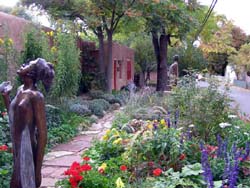
Most people come to Santa Fe to relax, so the nightlife is rather subdued. Several of the downtown hotels have nice bars, some with live music. Art collectors will love Santa Fe - there are literally dozens of high quality galleries, arts and crafts shops and Southwestern stores which offer a wide range of both Indian and contemporary art. Collecting Indian carvings, native
Kachina dolls and artifacts is a major preoccupation for many people who visit.
Canyon Road nearby town has many fine galleries offering paintings, sculptures, woven and carved goods and numerous works to complement any collection.
More Santa Fe shopping...
Santa Fe Attractions
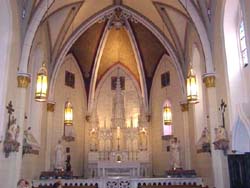
The
Georgia O'Keefe museum downtown celebrates it's 10th anniversary in 2007 and offers a glimpse into the life of the artist who made the area her home and love. Having a cocktail in the bar at
La Fonda and enjoying the sunset from the rooftop deck by the bell tower are both fun. The Plaza in the center of downtown hosts dozens of Indian artists daily offering jewelry, paintings, carvings and woven goods. All downtown Santa Fe is a National Historic District; old Route 66 runs through town by the Santa Fe trail which brought settlers West.
Bandelier National Monument outside of town gives breathtaking views of ancient cliff dwellings, while old, beautiful buildings stand downtown including the
Palace of the Governors,
Saint Francis Cathedral,
Loretto Chapel and
San Miguel Chapel- the oldest operating chapel in the United States. The
La Fonda Hotel is considered a great example of Pueblo style architecture and the
State Capital nearby is built in the shape of a Zia sun symbol, offering sculpture and art exhibits.
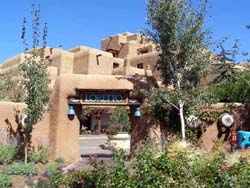 We recommend spending a few days just relaxing in Santa Fe (the Inn and Spa at Loretto is rustic and wonderful and right downtown). You come to Santa Fe to enjoy good Southwestern food, shop and collect art - but take time to drive into the desert to explore the beautiful canyons and Indian ruins. Photographers and artists love the area - it will provide you with many great memories and places to visit again. More Santa Fe attractions...
We recommend spending a few days just relaxing in Santa Fe (the Inn and Spa at Loretto is rustic and wonderful and right downtown). You come to Santa Fe to enjoy good Southwestern food, shop and collect art - but take time to drive into the desert to explore the beautiful canyons and Indian ruins. Photographers and artists love the area - it will provide you with many great memories and places to visit again. More Santa Fe attractions...

By the 1800's, the Spanish empire was crumbling; war with the United States in 1846-1848 resulted in much of the present day Southwestern U.S. being ceded to the U.S. in the most significant nation building move since the Louisiana Purchase. Railroads transformed Santa Fe in the 1880's and the town became a major Western trading post. New Mexico finally became a state in 1912 after several failed attempts, with President Taft signing the statehood bill.
We recommend spending a few days just relaxing in Santa Fe (the Inn and Spa at Loretto is rustic and wonderful and right downtown). You come to Santa Fe to enjoy good Southwestern food, shop and collect art - but take time to drive into the desert to explore the beautiful canyons and Indian ruins. Photographers and artists love the area - it will provide you with many great memories and places to visit again. More Santa Fe attractions...
